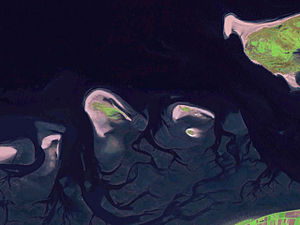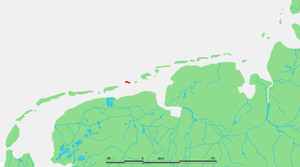Rottumeroog
| Rottumeroog | ||
|---|---|---|
| v. l. To the right: Eastern tip of Schiermonnikoog, Simonszand, Rottumerplaat, Rottumeroog with the Zuiderduintjes and the western part of Borkum | ||
| Waters | North Sea | |
| Archipelago | West Frisian Islands | |
| Geographical location | 53 ° 32 ' N , 6 ° 35' E | |
|
|
||
| length | 2 km | |
| width | 1 km | |
| surface | 250 hectares | |
| Residents | uninhabited | |
| Location within the Frisian Islands | ||
The island of Rottumeroog , or Rottum for short , is the easternmost and smallest of the West Frisian islands . Rottumeroog has been uninhabited since the last beach bailiff left the island in 1965. Only a few security measures are carried out by the state. As a bird island, Rottum is of great importance for the populations of numerous coastal bird species.
Rottumeroog is currently about 250 hectares in size, but is getting smaller and smaller and is in danger of disappearing, as less is growing at the east end at the mouth of the Ems than is carried away by the current at the west end. The nearby sandbank Rottumerplaat , on the other hand, is slowly developing into a new island.
history
Like Schiermonnikoog , the island of Rottumeroog was owned by a monastery in the Middle Ages. Two thirds of the island belonged to the eponymous Benedictine monastery at Rottum in the south of Usquert and one third belonged to the Premonstratensian monastery near Kloosterburen ( De Marne ), the Oldenklooster. From 1523 to 1524 the island was used as a hiding place by the pirate Cornelius Vehr. His stay on the island became known through a betrayal and soldiers of Count Edzards of East Friesland arrested him and seven of his crew, they were beheaded in Emden. This property passed to the Staten van Groningen in 1594 , where the Reformation was victorious 14 years later than in the province of Friesland . Before that, the Groningen water geuse Barthold Entens van Mentheda had the island under his control.
In 1608 the Staten van Groningen gave the island to Johan Sickinghe, who had granted them a loan, as pledge. After the loan was repaid, the island was leased several times. In 1659 the states sold them. In the second half of the 17th century , one owner followed another in quick succession. The value of the small island, which was repeatedly hit by storm surges , steadily declined.
The most spectacular owner of Rottumeroog from this period is undoubtedly Donough MacCarty , Earl of Clancarty (1707–1734). This Irish nobleman had gone into exile as a supporter of the English King Jacob II, who was expelled in 1688 .
In 1738 Rottumeroog came back into the possession of the Staten van Groningen. 60 years later the island became the property of the Dutch state .
The island belonged to the municipality of Warffum , which was incorporated into Eemsmond in 1990 . This in turn has been part of the municipality of Het Hogeland since 2019 .
cards
Map of Rottum and the lost island of Bosch before 1682





